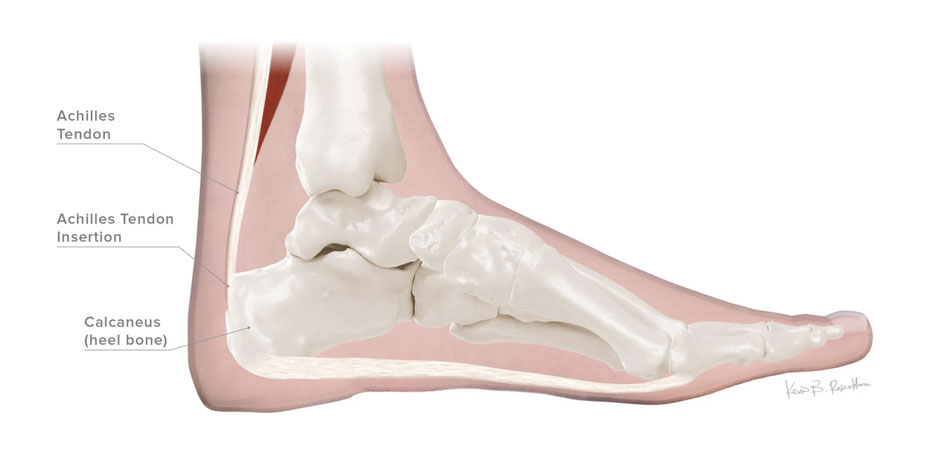This post is about the marvelous adaptations/compensations that our bodies make when the achilles is not quite right. Let’s start with the easy stuff concerning equinus forces when the achilles tendon is not flexible enough. So, you have measured a tight achilles. Remember to differentiate between the tightness in the gastrocnemius and soleus so you can start them on an appropriate stretching program. Stretching the achilles two or three times a day tends to give 2 or 3 degrees of flexibility gains per month, so for your super tight patients this process may take months to get them into a normal range. During the time they are too tight, this tightness forces them to compensate as they move their foot from heel contact to toe lift. These various compensations each have problems associated. Each person will choose a different compensation from over pronation, to early heel lift, to genu recurvatum, or to the widening of their angle of gait.

The first type of compensation occurs at the subtalar joint. When the ankle can not bend forward to move the body's weight due to a tight achilles tendon, the subtalar joint can overly pronate to loosen the foot. This hypermobility of the foot allows weight transfer as the foot plantar flexes the many midfoot joints to allow a sagittal plane midfoot collapse or bend that should not be occurring. When the foot should be getting more and more stability in midstance and propulsion, it is getting more and more unstable with this pronatory compensation. Injuries and pain syndromes are varied with symptoms occurring from the foot to the low back. Dr. Donald Green, renowned Podiatrist, emphasized that compensations for any plane tend to break down the foot primarily in that plane. His theory, which is well accepted, is called Planal Dominance*. According to Dr. Green, since a tight achilles is a Sagittal Plane deformity, its most devastating effects will center around a sagittal plane collapse of the arch, or a sagittal plane hyper-extension at the knee. Also, the concept of joint instability, when a joint should be stable but is not, leading to joint dysfunction and pain should explain a lot of problems we face treating our patients. Dr. Merton Root’s basis of his functional foot custom made orthotic device was based on preventing these dysfunctions from occurring.
This leads us to the second type of compensation for a tight achilles tendon–knee hyper-extension aka genu recurvatum. The sway back knees can be so damaging to the knees, and you are typically picking this up when the patients are young. These patients have to be told to only stretch the gastrocnemius with the knee slightly bent (5 degrees or so) in order to protect these knee joints. This is a great example of a sagittal plane deformity leading to a sagittal plane problem.
Another common compensation for a tight achilles tendon is the development of a bouncy gait with an early heel off, or no heel contact at all. Even though this may break down the midfoot, this compensation may supinate the subtalar joint and make the patient very stable and a good athlete. The spectrum of this sagittal plane compensation is broad. Whether you observe a slight problem with heel lift timing (early in this case), or a noticeable single or double heel bounce, or straight toe walking with no heel contact, consider an equinus. There are neurological conditions, with normal achilles flexibility, which produce the same gait findings so please measure the achilles length. One of the most obvious problems with this issue concerns increased weight bearing in the metatarsals and subsequent deformities and pain syndromes.
The last compensation for a tight achilles is the development of an out toed gait. I have seen this only in patients with other transverse plane problems like high external femoral torsion, high malleolar torsion, or a high subtalar joint axis. It is natural for these patients to compensate for their ability to move in the sagittal plane to add some transverse plane into the mix. What are the common problems I see with an excessive out toeing gait (with one of the causes being a tight achilles tendon)? First of all, their knees will not line up with the feet if the external component comes from below the knees. This malalignment syndrome can cause knee pain. When the foot and knee are both out from external femoral problems, the patient may break down their shoes terribly on the lateral side and be supinators, or trying to move in a forward sagittal direction may cause terrible pronation. Your gait findings and biomechanical exam will point to the appropriate treatment. This is a very difficult case, as are many transverse plane issues. Next week I will talk about problems related to a weak achilles no matter the cause.
*J Am Podiatry Assoc 1984 Feb;74(2):98-103. doi: 10.7547/87507315-74-2-98






